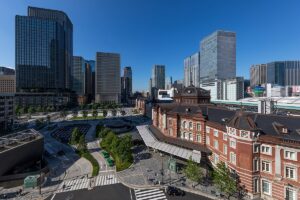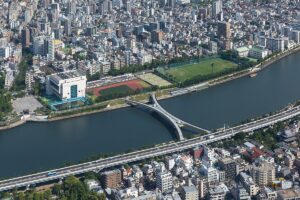Overview (history, characteristics, attractions)
Mount Haguro, one of the Dewa Sanzan (Mount Haguro, Mount Gassan, and Mount Yudono) in Tsuruoka City, Yamagata Prefecture, has long been known as a sacred place of mountain worship and Shugendo (Asceticism). At the summit, the Sanjin Gosaiden (Sanjin-Gosaiden), which enshrines the gods of the three mountains, has attracted pilgrims as a place of worship since the Heian and Kamakura periods. The approach to the mountain features 2,446 stone steps and rows of aged cedar trees, some hundreds to thousands of years old, creating a fascinating landscape that combines natural beauty with history. The five-story pagoda (a National Treasure) on the grounds is particularly famous, and the combination of the cedar trees and the tower is a popular photo spot. Another major attraction is the ability to enjoy the changing seasonal scenery (fresh greenery, deep greenery, autumn leaves, and snowscapes).
Highlights
– 2,446 stone steps and a path lined with old cedars: The moss-covered stone steps and tunnel of giant cedars are a sight to behold. The experience of walking along the path in a tranquil atmosphere is unique to Mount Haguro.
– Five-story pagoda (national treasure): The wooden five-story pagoda standing halfway along the approach to the temple is a designated national treasure. Together with the surrounding cedar trees, it is a highlight of the scenery.
– Sanshin Gosaiden (mountaintop): Located at the summit of Mt. Haguro, Gosaiden is a shrine that enshrines the gods of the Dewa Sanzan mountains. It is the center of worship and pilgrimage.
- Zuishinmon Gate and Subsidiary Shrines: There are Zuishinmon Gate and many small shrines scattered along the approach to the shrine, making for a pleasant stroll.
- Shugendo and Yamabushi culture: There are events and experiences held by Yamabushi (mountain ascetics), giving you the opportunity to experience Shugendo culture (depending on the season and events).
- Four Seasons Scenery: Enjoy the different looks of each season, such as autumn leaves, winter snow, and summer deep green.
Access (nearest station, transportation, etc.)
- Train/Bus: The nearest major station is Tsuruoka Station on the JR Uetsu Main Line and Rikuu West Line. From Tsuruoka Station, take a Shonai Kotsu bus to Haguro (route and timetable may vary depending on the season). The journey takes approximately 30-40 minutes. Please note that buses run only a limited number of times, so please check the timetable in advance.
- By car: Approximately 20-30 minutes by car from the center of Tsuruoka City (depending on road and traffic conditions). Parking is available around Mt. Haguro (paid or free depending on location). In winter, snow chains or studless tires may be required due to snow accumulation.
- Taxi: Approximately 20-30 minutes by taxi from Tsuruoka Station. Convenient for groups or those with elderly people.
- On foot: The most common route to visit the shrine is to walk up the approach (2,446 stone steps). Please make sure you have enough time and energy to do so.
Estimated stay (estimated time required)
- Short time (visiting the five-story pagoda and part of the approach): Approximately 1 to 1.5 hours
- Standard (climbing the stone steps to the summit and visiting the Sanshingosaiden shrine): Approximately 2-3 hours (depending on walking speed and break times)
- Relaxed (walking along the approach to the shrine + exploring the surrounding area, taking photos, and having a snack): Half a day (3-5 hours)
- If you include sightseeing in the surrounding area: A one-day plan is recommended (combined with sightseeing in Dewa Sanzan, hot springs, and Tsuruoka city).
Nearby spots
– Mt. Gassan and Mt. Yudono (Dewa Sanzan): These are the other two peaks of the Dewa Sanzan, which are visited together with Mt. Haguro. Please be aware of the seasons and rules for visiting.
– Yunohama Onsen: A hot spring resort along the Sea of Japan, convenient for swimming and lodging.
– Kamo Aquarium (near Tsuruoka): Famous for its jellyfish exhibits (check opening hours and closing days in advance).
– Chido Museum (Tsuruoka City): Exhibits cultural assets and materials related to the Tsuruoka domain.
– Tsuruoka City: Dotted with spots where you can enjoy local food, historical buildings, and local sake.
Things to be aware of (crowds, manners, seasonal precautions, etc.)
– Clothing and shoes: The stone steps leading to the shrine have uneven steps and moss that can make them slippery in places, so we recommend wearing comfortable shoes (trekking shoes or sneakers). Be especially careful in rainy or snowy weather.
- Physical strength and time allocation: The 2,446 steps are long and steep in places, so please take breaks and do not push yourself too hard. In summer, take measures to prevent heatstroke, and in winter, wear warm clothes and anti-slip footwear.
- Number of buses: There are limited buses between Tsuruoka Station and Haguro, so please check the return time before making your plans. There may be fewer buses running, especially in the evening.
- Photography and worship etiquette: Please be quiet when worshiping at the shrine. Of the Dewa Sanzan mountains, there are areas on Mount Yudono where photography is prohibited, so if you are touring other mountains, please respect the rules of each facility.
- Crowds: The approach and parking lot can get crowded during the autumn foliage season and on long weekends. Visit early in the morning or on a weekday to have a more leisurely time.
– Protect the natural environment: take your trash with you and avoid damaging plants and tree bark.
- Consideration for religious events: Shugendo and Shinto rituals may be taking place, so if you come across an event, please follow the instructions and observe quietly.
(Note) For the latest traffic information, visiting hours, special events, and winter closures, please check the official Tsuruoka City Tourist Information, Shonai Kotsu, Mt. Haguro website, and the city's tourism website before visiting.



